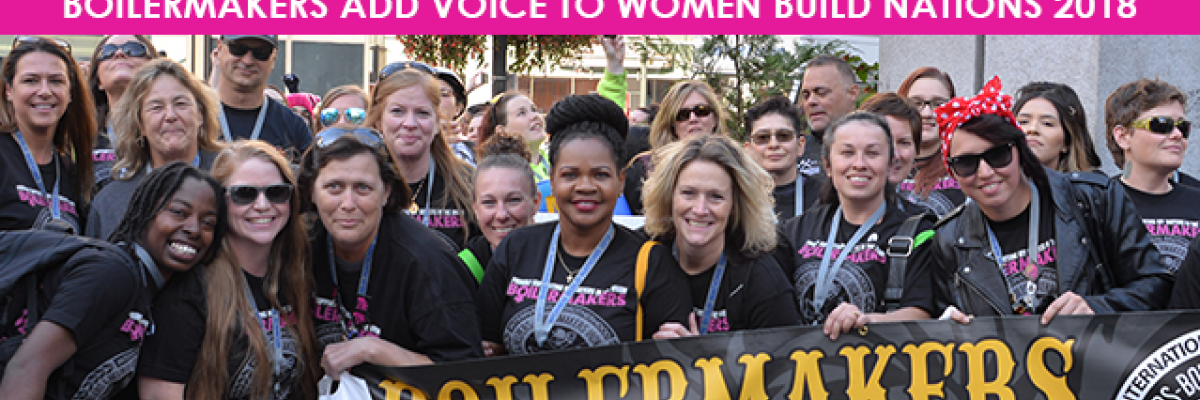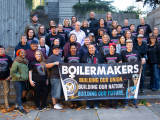“Being in the trades changed my life. That’s why I’m so passionate to go into schools and work with youth. My folks wanted me to be a ‘real’ missionary, and now I’m a skilled trades missionary.”
— Jamie McMillan, L-146
IR Erica Stewart helps emcee the plenary sessions at Women Build Nations.
View Photo Gallery (7 photos)
Over 50 Boilermakers attend eighth annual event
THEY’RE LOUD, THEY’RE proud, and they want their union brothers to know they’re capable on the job. That was the mantra of 52 Boilermakers along with 2,200 other skilled tradeswomen and union representatives who gathered for the 2018 Women Build Nations conference in Seattle October 12-14, sponsored by the North American Building Trades Unions.
The weekend conference offered plenary sessions, breakouts with topics germane to women in the construction trades and a caucus for Boilermakers that focused on apprenticeship training. Tradeswomen also flooded downtown Seattle for a Saturday afternoon rally promoting women in the trades. The march demonstrated the growing number of women in skilled trade unions and the growing attendance at the conference.
Sean McGarvey, NATBU president, said that if the WBN conference growth continues at its current pace, it will quickly become the third-largest gathering for the North American Building Trades. He called women in the building trades “trailblazers.”
“Tradeswomen, you do build nations! Your contribution is essential, and your impact is mighty,” he said. “You are leading change to diversify the building trades.”
Moving ahead in the face of challenges
GAINING DIVERSITY IN the trades isn’t without a few growing pains, according to the work stories of numerous women at the conference. The construction trades have been a male bastion for decades. With more skilled women on job sites, men are learning to make room in an industry that has been largely theirs for over a century.
Local 13 (Philadelphia) apprentice Amanda Mortillite said she indentured into the Boilermakers intending to be put to work. But when she first started, she’d show up on a new job site and hear the older men call, “Your dad let you out?”
She said she knows it was a protective reaction, but when she first started as an apprentice, she felt frustrated.
“They’re thinking of their daughters,” said Mortillite, with a slight smile and knowing nod. “Journeymen are afraid I’m going to get hurt. I get that. But I want to work, and they push me aside.”
That is, until her latest job where her foreman — and a male advocate on the job — started telling everyone to put her to work. “Now I’m actually getting to do things. Not just watching.” And while women still aren’t the norm on construction sites, Local 83 (Kansas City, Missouri) BM-ST Scot Albertson said it’s better than it was two decades ago. He remembered that in 1998 a woman walked on the job and several men made the comment, “This is a man’s world and she doesn’t belong.”
Today, Local 83 has 16 women journeymen and six apprentices. “I would work with any of them any day,” said Albertson.
As far as challenges for women in the trades, he believes the industry has become far more understanding. “They’re here for the same reason as everybody else: to earn a good living and support a family, which is the same challenge facing each and every member.”
Piquing interest in the trades
WOMEN IN TRADES are here to stay. When more women decide on a career in the construction trades, it demonstrates to younger women choosing a vocation that the trades are an option. Conference speaker Dr. Patricia Greene, director of the U.S. Department of Labor’s Women’s Bureau, said women make up 47 percent of the workforce, and there are indications of increased interest in the trades among women.
“We’re starting to get a lot more attention on apprenticeship programs,” said Greene. “The trades can be a great path for careers.”
That’s something Jamie McMillan, Local 146 (Edmonton, Alberta), discovered in her 20s. The trades, she said, transformed her life. “All of a sudden, I went from wanting to die to loving my life.”
“They’re here for the same reason as everybody else: to earn a good living and support a family, which is the same challenge facing each and every member.”
— Scot Albertson, L-83
That’s why, after over 10 years on the tools, she now takes six months off the jobsite and goes into schools to tout the trades through Kick Ass Careers, a program she founded. She shared her story in a morning breakout session.
“Being in the trades changed my life,” said McMillan. “That’s why I’m so passionate to go into schools and work with youth. My folks wanted me to be a ‘real’ missionary, and now I’m a skilled trades missionary.”
Female role models and mentors are important — another reason McMillan is committed to being in the schools. “I started to see a difference with students who were dropping out of high school, and now, they’re doing really well in skilled trades,” McMillan said.
Nydia Daley, a helper-turned-apprentice from Local 549 (Pittsburg, California) agrees there is a need for more mentors.
“We need more women in the trades, because representation matters,” said Daley. “When I entered the trades, I didn’t have [any female role models] to look up to. When I got to the union hall, it was all men. When I got to the job site, it was all men. If there were more women to look up to, there’d be more women in the trades.”
McGarvey said he welcomes more women into the construction trades. “We will continue to break down challenges for women in our industry. That’s what we’re all about in the building trades. Equality for all.”













